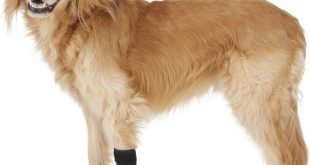In this article I will be discussing the best no knuckling training sock on the market and how I discovered it. Walkin’ Rear No-Knuckling Training Sock has helped my dog have a much higher quality of life. I whole-heartedly recommend it to any dog owner whose is suffering from Knuckling.
As the owner of a Kennel, I own quite a few dogs and I am a proud parent of a middle-aged lab mix (of about 7 years old). A few months ago, I noticed my dog dragging the top of his hind paw along the ground. As he walked, he bent his wrist, flipping his paw under his leg. He also walked on the top of his foot rather than on the bottom. He would walk fine at times but then knuckle hard, often bruising the top of his feet.
Little did I know, these were early signs of an emerging neurological disorder which affected the mobility of his left Hind leg. Unfortunately, his condition continued to deteriorate quite quickly. It was heartbreaking!
Found a Solution in Walkin’ No-Knuckling Training Sock

Out of desperation, I went online to look up brace support options. That’s when I discovered this miracle product. Walkin’ Rear No-Knuckling Training Sock had the best reviews and was the perfect product considering it was to be used for the rear leg. I contemplated and searched for other solutions at first but eventually ordered it.
Although it took my dog a couple days to adjust to walking in it, after a while he adapted. He was able to wear it for 15-25 minutes walks. To my amazement, he was continuously showing signs of improvement and adjustment after each walk. After having him wear it for about a month, he is now able to tolerate the brace, and his gait is getting way better. The brace helped him support the process of lifting the foot properly and placing it.
I am pleased to say that this has worked very well in improving how he walks. If you have a dog suffering from this issue, you should try this product out. It is worth it.
Now you are probably wondering, what could have caused this knuckling in the first place?
Well, the truth is that the causes for knuckling vary wildly. Discussed below are some conditions believed to cause knuckling in dogs.
Sore Paws

If your dog has a sore foot caused by cuts, wounds, or burns from walking on hot asphalt,
knuckling can occur on any of his feet. This can be easily treated if this is the cause. Thankfully, the knuckling resulting from this does not last long and is usually resolved once the wound heals.
You should however address any form of injury quickly to ensure that the problems do not escalate. Also ensure that your dog doesn’t injure the top of his foot by dragging it along the ground.
Broken or infected nails could also cause some form of knuckling. This happens when your dog’s nail gets split from wearing or a sudden impact. If it caused some sort of irritation and pain to your dog this could cause him to start knuckling.
Carpal Flexural Deformity

Carpal Flexural Deformity is a condition that can occur in puppies when they go through growth sprouts.
It can happen when your dog’s wrists haven’t properly developed enough to bear their body weight and then caused his wrist or joints to bulge out. This eventually forces the foot to knuckle under.
Sometimes, this condition is caused by an excess of protein and is more common among large dog breeds like Great Danes, German Shepherds, and Dobermans.
In most cases, your puppy’s wrists will straighten out on their own after a few weeks. Also, physical therapy exercises are also a helpful form of treatment in this case.
Degenerative Myelopathy

If your dog suffers from Degenerative Myelopathy it’s likely that your dog’s knuckling is caused by a genetically inherited condition that impacts his mobility.
This condition develops when your dog has a loss of myelin (the white matter sheathing its spinal cord). Loss of myelin can cause your dog to lose control over certain muscles.
Unfortunately, there is no known cure for this condition. It is also progressive and worsens as time goes by. This condition is most common among older dogs and can eventually cause total loss of mobility to your dog.
Intervertebral Disc disease

This is a spinal condition that mostly affects older dogs. However, it can also affect smaller dogs because of physical trauma.
Intervertebral Disc disease causes the disc in your dog’s spine to deteriorate therefore causing the bones to rub against each other causing damage to the spine itself.
In most cases, this would cause your dog to suffer from backaches, stiffness, lack of coordination, stumbling, collapsing, weakness, knuckling his paws, sensitivity to touch and movement, and potential paralysis.
Fibrocartilaginous Embolism

This is also a spinal condition mainly caused by exercise trauma. It can cause a piece of your dog’s intervertebral disc to detach and end up in a blood vessel which can lead to an embolism.
This can also cause a part of your dog’s spinal cord to die, and make it lose functionality of one or several limbs thus impacting its mobility.
Tumors:
Although this is very rare, tumours can cause knuckling depending on their location.
Tumours may grow in locations where they affect parts of your dog’s spinal cord and could lead to knuckling. Both cancerous and benign tumours can cause knuckling depending on where they are located.
Nobody likes to see his/her dog walking in a disorderly manner, going through pain and bruising itself. The table below is meant to guide you towards picking the right product for your knuckling dog.
What are the Best Training Socks for Knuckling in Dogs you can find?
For this review of the training socks, we are focusing on these products which have the best feedback from dog parents.
Rear Walkin’ No-Knuckling Training Sock and Front Walkin’ No-Knuckling Training Sock
Rear Walkin’ No-Knuckling Training Sock and Front Walkin’ No-Knuckling Training Sock are two revolutionary products manufactured by Walkin’ pets to help dogs with IVDD (Intervertebral disc disease), DM (Degenerative Myelopathy), Wobblers (CVI), Cervical Disc Disease, FCE(fibrocartilaginous embolism), and Neurological disorders.
Also, since they work in the same way apart from one tackling the front legs while the other tackles the back legs, they will be reviewed together.
You can purchase any of this starting from $69.95 across different online stores.
What are the uses of the rear/front Walkin’ No-Knuckling Training Sock?

These products are built to create support for dogs who drag their front paws or hind paws while walking. They work by stimulating your dog between its toes and causing a withdrawal reflex that makes him/her raise the foot higher.
If your pet is recovering from spinal surgery or suffering from disc disease, these products can be used for rehabilitative purposes.
How can the rear/front Walkin’ No-Knuckling Training Sock be used?
They are lightweight, comfortable for your dog, and very adjustable. Walkin’ No-Knuckling Training Socks are made from a durable neoprene material that has an extra fleece pad and toe cord cushioning to offer a comfortable fit for your pet with weak hind legs.
You can use these products on your dog for two to five minutes exercise walks throughout the day and remove them in between walks.
To use this product on your dog, take the following steps.
- Spread open the Walkin’ No-Knuckling Training Sock, attaching each strap to itself while keeping it open. Then wrap the NKTS around the hock joint on your dog’s lower hind leg. Be sure to keep the cord loop-free and positioned in front of your dog’s leg.
- Keep the cord loop-free and over straps, then secure touch fastener straps, starting with the bottom. Then secure the top strap. Finally, if there is a third strap, tighten it last, below your dog’s hock joint.
- Wrap the fleece pad around the toe portion of the cord loop. This will add extra padding between the cord and toes.
- Position the cord loop around and under your dog’s middle two toes.
- Tighten slowly and test your dog’s reaction. If you don’t notice a reaction, gradually tighten more and test again.
Note; do not wrap the No-Knuckling Training Socks too tight that it begins to interfere with circulation, or limit your dog’s rear leg mobility.
Do not tighten the cords to the point where it causes irritation or pulls your dog’s toes up too far.
It is also necessary that you use the recommended size for your dog.
The sizing is as Follows
- 10-15lbs, and measures 2 inches from the top of its paw to the middle of its carpal joint, an Xsmall size is required.
- 15-25lbs, and measures 2.25 inches from the top of its paw to the middle of its carpal joint, Small size is required.
- 20-60lbs, and measures 2.5 inches from the top of its paw to the middle of its carpal joint, a Medium size is required.
- 60-100lbs, and measures 2.75 inches from the top of its paw to the middle of its carpal joint, Large size is required.
- Over 100lbs, and measures about 3 inches or greater from the top of its paw to the middle of its carpal joint, XL size is required.
What are the possible downsides of using the rear/front Walkin’ No-Knuckling Training Sock?
These are mostly associated with the inability of some users to use these products the right way.
For instance, if they are too right, these products might restrict your dog’s circulation and could also irritate.
So it is advisable to use it under vet supervision.
Would you recommend rear/front Walkin’ No-Knuckling Training Sock for dog owners?
The short answer is yes! Walkin’ No-Knuckling Training Socks are lightweight products, and they are comfortable if used properly. They will also help train your dog to lift its paws higher and improve its gait. It is very useful if you have a dog suffering from knuckling.
Also Consider Product you should get for your Dog
Traction Socks
These are similar to no-knuckling boots and also produced by Walkin’ pets.
But these Traction Socks do not provide stabilizing support, but they will, however, protect the feet.
They have a waterproof silicone gel sole to keep your dog from slipping or splaying out on slippery or smooth flooring.
The upper sock is warm and cozy with a detachable strap that keeps the socks in place.
These Traction Socks are great for senior and tri-pawed dogs who need more traction on slick surfaces, with the bonus of protecting hardwood floors at the same time!
They are super easy to use, just put them on your pup like any regular socks and you’re good to go.
You can purchase these socks starting from $47 across online stores.
Conclusion
Please note that knuckling can occur in both your dog’s hind legs and forelegs. Also, if left untreated, Knuckling can also cause injuries to your dog. It is therefore important to find products that can help protect and help your do correct its Knuckling problem before it leads to serious injury.
 Total Pooch Dog Supplements, Tear Stain Removers, De-wormers, Tylosin for Dogs and other great products.
Total Pooch Dog Supplements, Tear Stain Removers, De-wormers, Tylosin for Dogs and other great products.



